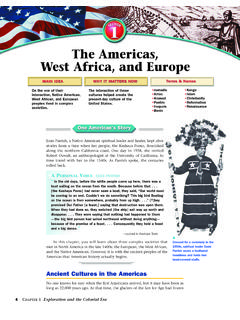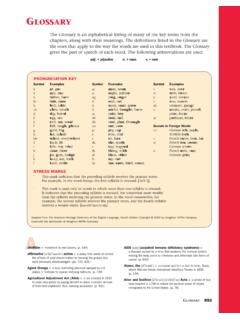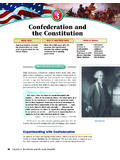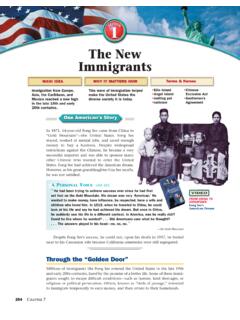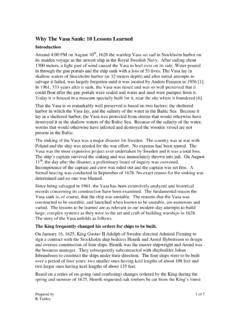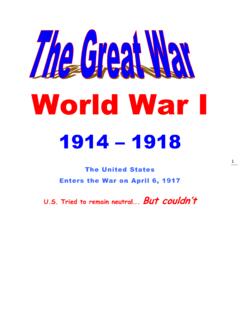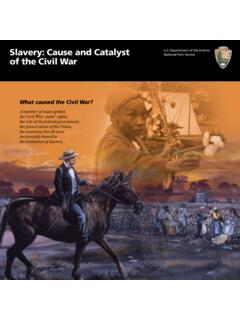Transcription of The Spanish- American War
1 Terms & NamesTerms & NamesMAIN IDEAMAIN IDEA Jos Mart Valeriano Weyler yellow journalism Maine George Dewey Rough Riders San Juan Hill Treaty of ParisIn 1898, the United Stateswent to war to help Cuba winits independence from involvement in LatinAmerica and Asia increasedgreatly as a result of the warand continues IT MATTERS NOWWHY IT MATTERS NOWE arly in 1896, James Creelman traveled to Cuba as a New YorkWorldreporter, covering the second Cuban war for independ-ence from Spain. While in Havana, he wrote columns about hisobservations of the war. His descriptions of Spanish atrocitiesaroused American sympathy for PERSONALVOICEJAMES CREELMAN No man s life, no man s property is safe [in Cuba]. Americancitizens are imprisoned or slain without cause. American prop-erty is destroyed on all sides.. Wounded soldiers can befound begging in the streets of Havana.. The horrors of abarbarous struggle for the extermination of the native popula-tion are witnessed in all parts of the country.
2 Blood on theroadsides, blood in the fields, blood on the doorsteps, blood,blood, blood! .. Is there no nation wise enough, brave enough to aid this blood-smitten land? New York World, May 17, 1896 Newspapers during that period often exaggerated storieslike Creelman s to boost their sales as well as to provokeAmerican intervention in Rebel Against SpainBy the end of the 19th century, Spain once the most powerful colonial nationon earth had lost most of its colonies. It retained only the Philippines and theisland of Guam in the Pacific, a few outposts in Africa, and the Caribbean islandsof Cuba and Puerto Rico in the INTEREST IN CUBAThe United States had long held an interest inCuba, which lies only 90 miles south of Florida. In 1854, diplomats recommend-ed to President Franklin Pierce that the United States buy Cuba from Spain. TheSpanish responded by saying that they would rather see Cuba sunk in the American 's StoryThe Spanish- American War Cuban rebels burnthe town of Jarucoin March American interest in Cuba continued.
3 When theCubans rebelled against Spain between 1868 and 1878, American sympathies went out to the Cuban Cuban revolt against Spain was not successful, butin 1886 the Cuban people did force Spain to abolish the emancipation of Cuba s slaves, American capital-ists began investing millions of dollars in large sugar caneplantations on the island. THE SECOND WAR FOR INDEPENDENCEAnti-Spanishsentiment in Cuba soon erupted into a second war for inde-pendence. Jos Mart ,a Cuban poet and journalist inexile in New York, launched a revolution in 1895. Mart organized Cuban resistance against Spain, using an activeguerrilla campaign and deliberately destroying property,especially American -owned sugar mills and counted on provoking intervention to help therebels achieve Cuba Libre! a free opinion in the United States was split.
4 Manybusiness people wanted the government to support Spain inorder to protect their investments. Other Americans, how-ever, were enthusiastic about the rebel cause. The cry CubaLibre! was, after all, similar in sentiment to Patrick Henry s Give me liberty or give me death! War Fever EscalatesIn 1896, Spain responded to the Cuban revolt by sendingGeneralValeriano Weylerto Cuba to restore tried to crush the rebellion by herding the entirerural population of central and western Cuba into barbed-wire concentration camps. Here civilians could not give aidto rebels. An estimated 300,000 Cubans filled these camps,where thousands died from hunger and WARSW eyler s actions fueled a war over news-paper circulation that had developed between the Americannewspaper tycoons William Randolph Hearst and JosephPulitzer. To lure readers, Hearst s New York Journal andPulitzer s New York Worldprinted exaggerated accounts by reporters such asJames Creelman of Butcher Weyler s brutality.
5 Stories of poisoned wells and ofchildren being thrown to the sharks deepened American sympathy for the sensational style of writing, which exaggerates the news to lure and enragereaders, became known as yellow and Pulitzer fanned war fever. When Hearst sent the gifted artistFrederic Remington to Cuba to draw sketches of reporters stories, Remingtoninformed the publisher that a war between the United States and Spain seemedvery unlikely. Hearst reportedly replied, You furnish the pictures and I ll furnishthe war. THE DE L ME LETTERA merican sympathy for Cuba Libre! grew with eachday s headlines. When President William McKinley took office in 1897, demandsfor American intervention in Cuba were on the rise. Preferring to avoid war withSpain, McKinley tried diplomatic means to resolve the crisis. At first, his effortsappeared to succeed. Spain recalled General Weyler, modified the policy regard-ing concentration camps, and offered Cuba limited Claims an Empire347 AVocabularyguerrilla:amember of amilitar y force thatharasses theenemyMAIN IDEAMAIN IDEAAA nalyzingMotivesWhy did Jos Mart encourageCuban rebels todestroy sugar millsand plantations?
6 KEYPLAYERKEYPLAYERJOS MART 1853 1895 The Cuban political activist Jos Mart dedicated his life to achiev-ing independence for from Cuba at the age of16 because of his revolutionar yactivities, Mart earned a mas-ter s degree and a law eventually settled in theUnited y of the role in theCuban struggle against theSpanish, Mart warned, I knowthe Monster, because I have livedin its lair. His fears of impe-rialism turned out to have beenwell-founded. troops occu-pied Cuba on and off from 1906until died fighting for Cubanindependence in 1895. He isrevered today in Cuba as a heroand February 1898, however, the New York Journalpublished a private letterwritten by Enrique Dupuy de L me, the Spanish minister to the United States. ACuban rebel had stolen the letter from a Havana post office and leaked it to thenewspaper, which was thirsty for scandal. The de L me letter criticized PresidentMcKinley, calling him weak and a bidder for the admiration of the crowd.
7 The embarrassed Spanish government apologized, and the minister resigned. Still,Americans were angry over the insult to their MAINEEXPLODESOnly a few days after the publication of thede L me letter, American resentment toward Spain turned to outrage. Early in1898, President McKinley had ordered the Maineto Cuba to bringhomeAmerican citizens in danger from the fighting and to protect Americanproperty. On February 15, 1898, the ship blew up in the harbor of Havana. Morethan 260 men were the time, no one really knew why the ship exploded. In 1898, however, American newspapers claimed the Spanish had blown up the ship . The Journal sheadline read The warship Mainewas split in two by an enemy s secret infernalmachine. Hearst s paper offered a reward of $50,000 for the capture of theSpaniards who supposedly had committed the with Spain EruptsNow there was no holding back the forces that wanted war.
8 Remember theMaine! became the rallying cry for intervention in Cuba. It made no differ-ence that the Spanish government agreed, on April 9, to almost everything theUnited States demanded, including a six-month the Maineexploded in the harbor of Havana, newspapers like the New YorkJournalwere quick to place the blame on Spain. 348 CHAPTER10 MAIN IDEAMAIN IDEABS ummarizingWhat eventsincreased thetension betweenthe United Statesand Spain? May1,1898 PACIFICOCEANS outhChinaSea20 N10 N Hong ForcesBattle00100 200 kilometers100200 milesNSEWD espite the Spanish concessions, public opinion favored war. On April 11,McKinley asked Congress for authority to use force against Spain. After a week ofdebate, Congress agreed, and on April 20 the United States declared WAR IN THE PHILIPPINESThe Spanish thought the Americans wouldinvade Cuba. But the first battle of the war took place in a Spanish colony on theother side of the world the Philippine Islands.
9 On April 30, the American fleet in the Pacific steamed to the Philippines. Thenext morning, Commodore George Deweygave the command to open fire onthe Spanish fleet at Manila, the Philippine capital. Within hours, Dewey s menhad destroyed every Spanish ship there. Dewey s victory allowed troops toland in the Philippines. Dewey had the support of the Filipinos who, like the Cubans, also wantedfreedom from Spain. Over the next two months, 11,000 Americans joined forceswith Filipino rebels led by Emilio Aguinaldo. In August, Spanish troops in Manilasurrendered to the United WAR IN THE CARIBBEANIn the Caribbean, hostilities began with a navalblockade of Cuba. Admiral William T. Sampson effectively sealed up the Spanishfleet in the harbor of Santiago de Cuba. Dewey s victory at Manila had demonstrated the superiority of United Statesnaval forces. In contrast, the army maintained only a small professional force,supplemented by a larger inexperienced and ill-prepared volunteer force.
10 AboutAmerica Claims an Empire349 SantiagoShafterJune22 July1,1898 MilesJuly25 ,1898 CerveraMay,1898 SchleySampsonHavanaTampaPUERTORICOFLORID AC aribbean SeaATLANTICOCEANDOMINICANREPUBLICBAHAMAS (Br.)HAITIJAMAICA(Br.)CUBA15 NTropic of Naval BlockadeSpanish ForcesBattle00100 300 kilometers100300 milesGEOGRAPHY does Cuba lie in relation to the United States? at the location of the Philippines. How does themap help explain why Spain was surprised by the American attackin the Philippines?CWar in the CaribbeanWar in the PhilippinesThe Spanish- American War, 1898 MAIN IDEAMAIN IDEACA nalyzingEventsHow did theSpanish tr y toavoid war with theUnited States?125,000 Americans had volunteered to fight. The new soldiers were sent to train-ing camps that lacked adequate supplies and effective leaders. Moreover, therewere not enough modern guns to go around, and the troops were outfitted withheavy woolen uniforms unsuitable for Cuba s tropical climate.

